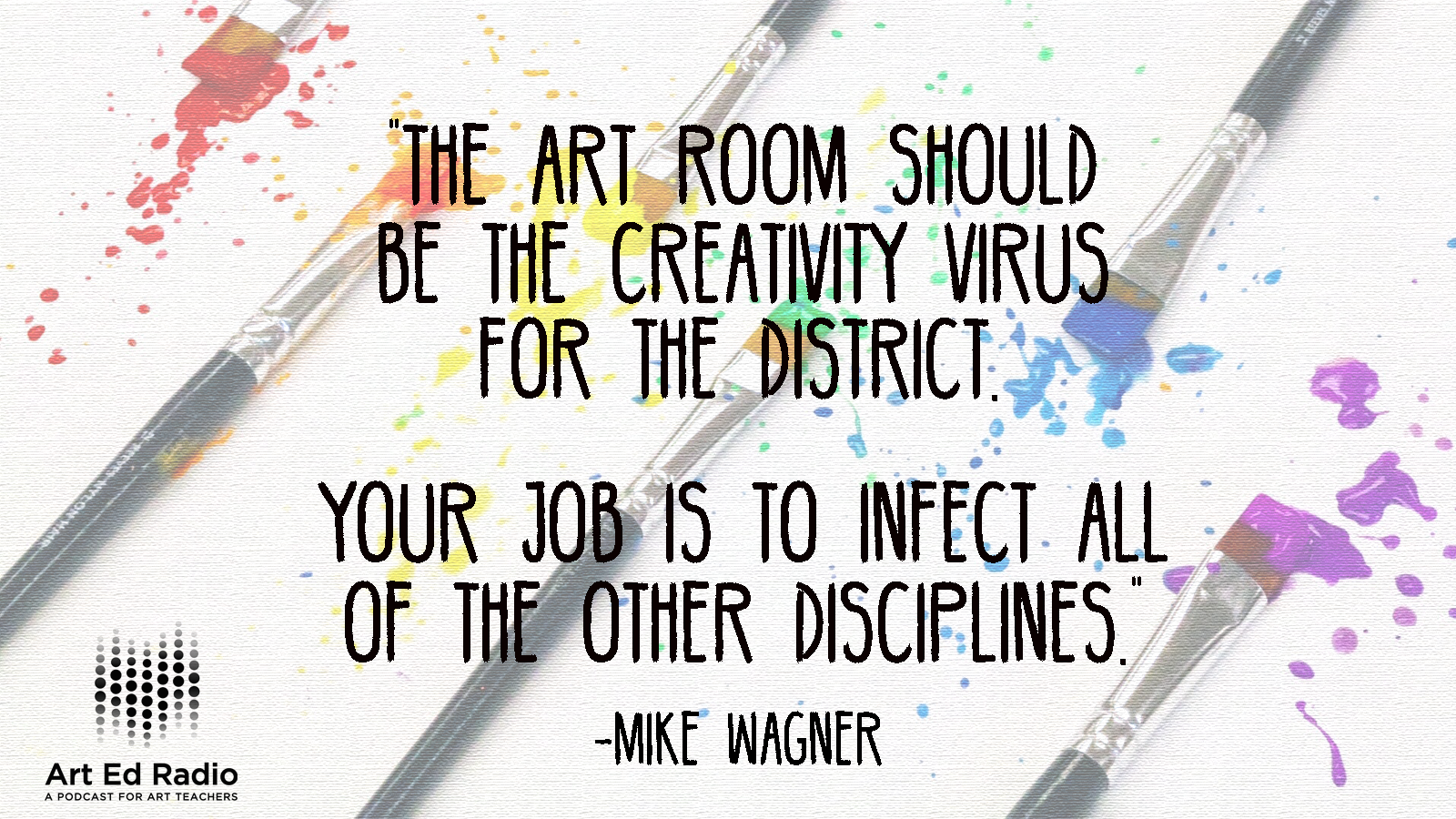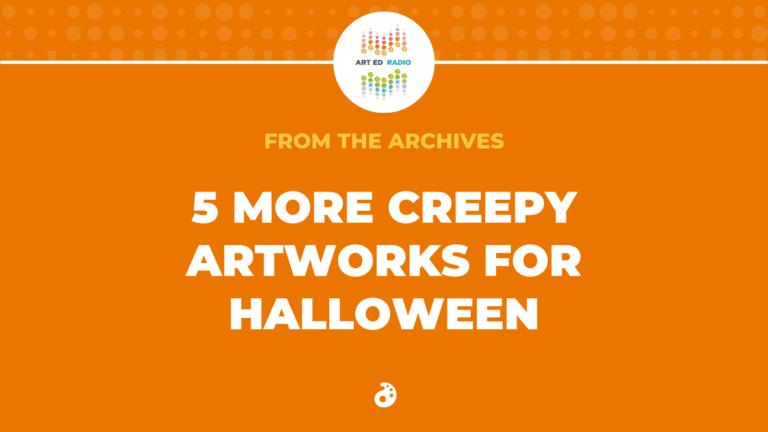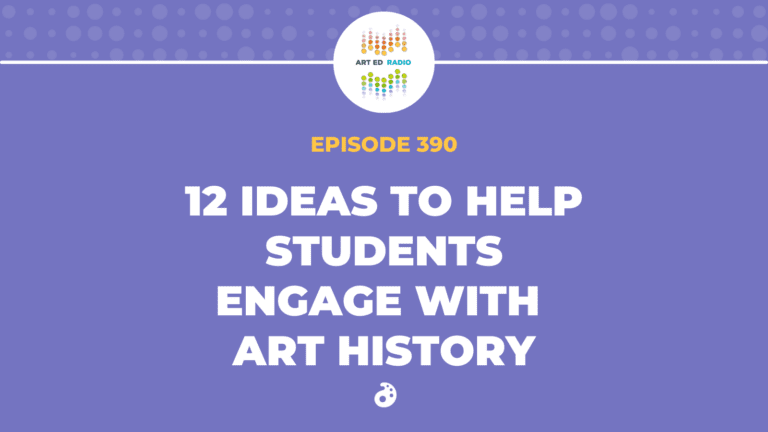Connections
Art Teachers are the Key to Growing the Creative Leaders of Tomorrow (Ep. 041)
November 29, 2016
Being able to think creatively is a vitally important skill to every area in education, and of course, art teachers do it best. Art is the vehicle for training students’ brains to be passionate about learning, creativity, and leadership. Andrew brings on an important outside voice, business leader Mike Wagner, to discuss arts and the ability to create innovative leaders for the future. Listen for their discussion on embracing divergent thinking (6:00), the meaning of innovation (12:30), and most importantly, how to advocate for the arts and creativity (17:00). Full episode transcript below.
Resources and Links:
- Mike’s TEDx talk–The Positive Power of Being Strange
- How to Teach for Creativity
- Thinking About Design Process Thinking
- Take a look at AOE’s Project Based Learning course

Transcript
Welcome to Art Ed Radio, the podcast for art teachers. This show is produced by The Art of Education, and I’m your host, Andrew McCormick.
Listen, we’ve all got those kids, right? Those kids, they’re a little apathetic and they just can’t seem to be bothered to work very hard on anything. They don’t really see the point in putting forth effort to make quality work. Their go-to move is to always ask why, why are we doing this? A little side note, I once had an administrator that told me that, forget teaching Generation Y or Generation Next or Millennials. Students today should be called Generation Wi-Fi, what’s in it for me? I kind of agree with that. I’ve been getting a lot of this apathetic attitude lately. Why are you so demanding Mr. McCormick? Why can’t I just turn this halfhearted, thoughtless, unimaginative, substandard work?
I’ve been trying to pull a complete 180 on them and really try to shock them by telling them what they don’t expect to hear which is the truth. I don’t really care if they graduate high school and never master illusionistic shading, if they never quite master drawing hands, okay. You know what kid, you’re right. “This” isn’t important, but you know what is important? The ability to think creatively, to think deeply, being able to communicate in a profound and abstract way through various platforms. That is important, and that is what art teaches. If you graduate and you haven’t built up your capacity for creativity, then I have failed. I’m not okay with that type of failure.
As an art teacher, I’m a little biased. I think we build this creative capacity better than anyone else. We see that the subject matter is important, but even more important is the mindset that it helps build, those creative mindsets. As we’re talking about creativity and how important it is for all students, even those apathetic ones, I’m super excited to have on another supportive voice from outside the art world in Mike Wagner.
Mike: Hi, this is Mike Wagner with White Rabbit Group.
Andrew: Mike is a big believer in the arts and their abilities to create innovative creative leaders down the road.
Mike: In a world full of change and the marketplace full of churn, it’s time to learn how to be a creative leader.
Andrew: Mike and I are both really passionate about the arts and how it can drive a creative and innovative revolution, but I’d like to think that all subjects, all teachers share this outlook on their curriculum, that art, in my case, or science or history or language arts for other teachers out there, is really just a vehicle for training student’s brains to be creative and passionate about learning and leadership and work, so that … If school is done right, it really lays the neural pathways so that students can remember that feeling. It’s like training for deep meaningful thinking when they really do hit their thing down the road.
As we dive into creativity and how the arts really prepare students for a future economy that favors innovation and critical thinking, I do think that it might force some art teachers out there to rethink how the art room looks. I mean, maybe the art rooms of the future would be a little less paint and paper and a little more 3D printers and graphic design. Now, no one out there is advocating for a full digital switch. I mean, I think students desperately need that tactile connection with the arts, but are you experiencing a technological shift in your district? Are you feeling the pinch of all things STEM?
Perhaps, we as art teachers need to learn how to sing a slightly broader tune, one that branches out into STEAM projects or PBL lesson plans. That’s why I am so excited to be teaching the Project-Based Art Room through The Art of Education. In this class, you’ll see connections in the arts and STEM, and you’ll also connect with other great like-minded teachers. The Project-Based Art Room is a three-credit class, and new sections start up every month. In fact, I’m teaching one this December. Head on over to theartofed.com and check this out along with all the other great classes under the Courses tab. All right, so let’s hear from Mike, and if you know him from his TEDx talks, you know that he has a voice that is made for radio. I better be careful or he might box me out of this sweet podcasting gig.
Hey Mike, thanks for coming on to talk tonight.
Mike: Great to be here Andrew.
Andrew: Hey, I watched your TEDx Talk a while ago about the power of being strange. For anyone out there who hasn’t seen it, I highly recommend checking that out. I know that that was recorded just a couple years ago, so do you still think that there are so many positive sides to being strange? What actually do you mean by being strange?
Mike: Let me talk about what I mean by being strange to start with. The theme with that particular TED conference was the space between, and so it was purposely ambiguous. We’re trying to provoke some thinking and generate some opportunity for speakers. What I thought about was this, is that whenever we see someone or something that’s different than us, an instinctive response is to create more space between us and what we think is strange. Yet, what the research seems to show is that it is teams coming together who are made up of diverse people and opinions and points of view trying to work on the same problem that turns into real solutions. I argued that the power of strange is getting past our instinctive distancing with one another and coming together and solving problems. We need each others’ strangeness, if you will, to be able to solve complex problems that no one lone genius is ever going to be able to figure out.
Andrew: It’s funny, we were talking off air a little bit before we got rolling, and we both got some good ideas to fix the state of education in the world. One of those things that, I think, ties into that is we think about when there is someone who has a really unusual idea or is different or strange. I think, often times, the knee-jerk reaction in education is shun that person. Get away from that person. Those ideas are contagious and horrible, and we’re just going to put our head down and stay the course. I mean, is it your experience that that’s kind of unfortunate, the case with education and large groups, large companies?
Mike: Well it is, in the sense that we don’t make space really well for people to have differing opinions or strange ideas. A big piece of my work when I’m working with teams is to make space for that to happen. We often talk about moving from wacky to workable. If we can’t have wacky ideas or have the freedom to propose those ideas, then it’s not likely that we’ll be able to mine out of the wackiness some workable, really great ideas. Organizations and teams and classrooms where you can’t be a little bit wacky, probably it’s not going to turn into anything that’s really particularly valuable at the end.
Andrew: That’s great. I don’t know if you’ve printed out t-shirts of that yet with that slogan, but I think you should. That’s a really good one, especially for art education people out there. It’s like, we do that really well, goofy, weird, wacky stuff, and then how does it filter down into something that’s workable and even, maybe this word is not great to say, but practical or something that relevant. You’re right. If you can’t start with wacky, you can’t get to something workable. That’s awesome. Mike, I know that-
Mike: All, you-
Andrew: The … Oh, go ahead.
Mike: Well, I was just going to say, all you end up with is predictable. Predictable sameness is not really in the marketplace, at least, very competitive and certainly not very interesting in the art world either.
Andrew: Right. I was going to say, I know your work primarily lies in the idea of leadership and shaking up how we view leadership and how we cultivate leadership. I’m wondering how you see my world, our world of art education fitting in with some of your creative ideas on leadership.
Mike: When I look at leaders and the importance of being competitive in the marketplace, obviously that’s the main space in which I work. I do look at a leader being able to do maybe what art teachers do. Now, you have to tell me if I’m wrong, but one of the things I think creative leaders need to do that is really, really valuable today is making space for what you and I just talked about, making space for wacky ideas. Giving permission, convening people in groups so that they have a challenge in front of them, having intentional ways to facilitate out them some of the wackiness so that we can find the solution, I think that’s a tremendous skill that great leaders going forward need to have.
Can you make space for people to think out loud, to try things, to explore creative possibilities? That’s one of the most important things. I think the follow-on piece to that is probably, again, maybe what I would imagine, at least, great art teachers do and that is being able to give constant feedback so that people don’t give up on their ideas too quickly, so that they keep trying, so that they understand that this is iterative. It doesn’t have to be perfect the first time, but that they get some feedback from their leadership that says, “Keep moving. Keep trying.”
One thing that’s really lacking in many places is the ability to give constructive criticism on one hand or praise for success on the other. Some people have noted that many of our marketplace cultures or business cultures are praise deserts, very little leadership giving very little feedback. Again, I think those are two things I look for in leaders today that are going to be important going forward tomorrow.
Andrew: Oh, that’s awesome. I think you nailed it on the head. I think you get art teachers in that I do think that that’s one of the things that we are pretty good at, is giving constructive criticism and giving feedback and praise that isn’t just, “Oh, you’re so good, good little Timmy.” It’s like, “I really like the way you shaded that area right there,” or “Great use of color,” so very specific feedback that lets them know it’s not just about this, if they’re good or not, but hard work and all of that, paying attention to details.
I’ve been focusing my school year a lot on an idea of grit and, like you said, it’s something that iterative and doing it again, sticking with it. It’s so often, I think, math education, science education, I pick on them a lot because they’re, in a lot of people’s mind, the polar opposites. It’s either wrong or right. In art education, it’s, I don’t know. Figure it out.
Mike: Yeah.
Andrew: Maybe you do like it, but could you like it more? Could it be more effective? Then there’s all these value scales and sliding judgments and ideas that the students have to grapple with, and I honestly don’t think that there is enough other times in the school day when they do those sort of things.
Mike: I agree. I think that the need for iteration, being able to set aside or combat instinctive desire to be perfect the first time. Certainly in a testing culture that it’s right or it’s wrong, students need a space where they can develop that kind of I’ll try, try, and try again. I’ll fail fast in order to succeed sooner. I need to keep moving. I think great teachers and great leaders create that kind of culture, that kind of classroom culture that allows students to thrive and ultimately, employees can thrive in the same kind of environment.
Andrew: The whole idea of trial and error and try, try, and try again, and learn from failure, it gets me thinking about this buzz word that gets thrown around a lot in education which is innovation and innovative. I know innovative leadership is a focus that you have. I just wondered, do you actually think that schools are actually being innovative or is that just one of those words we like to throw around. If you don’t think that schools in public education is being innovative, what do you think some barriers are for schools to be innovative?
Mike: That’s a great question. I know that the word is thrown around a lot in the marketplace as well, but I don’t think it usually has any substantial definition or meaning. The reason it’s being thrown around a lot in the marketplace is that almost everyone acknowledges that we’re in this incredibly rapid season of change and very dynamic workplace. Because of that, if we don’t change, there are some real threats to our ability to thrive. I don’t know how quickly schools can move to supply that to the employers. They often complain that they’re not getting that, but on the other hand, I don’t think they necessarily reward it themselves. I think we’re a little bit of a … I don’t have the answer, but I think it’s the right question to be puzzling over.
I had lunch last week with a senior leader of an insurance company, imagine that here in the Des Moines area, and I asked him, “Are you going through a little change or a lot of change in your industry?” He says, “The only word that I can think of is massive change.” That’s an industry that typically has been more stable and more change resistant, but everyone is facing it. If we can’t equip students to be creative in the classroom, how are they going to be creative when we put them into the workforce?
Andrew: Okay, I’m going to go off on a tangent here, but I actually think there is a missing piece of this equation. I actually think it’s probably parents, getting parents to have a buy-in and an understanding of what their child’s trajectory should look like. I know I’m a weird one here. Going back to being weird where I’ve really softened on my kids, my daughter is in 7th and 5th grade, on their grades. My daughter got upset she got a B, and I’m like, “I don’t care. That’s fine. What was really important is you’re learning.” For so many parents, I think the equation that got them to success is still what they think has to be for their own children, i.e., get good grades, go to school, get a degree, get a job. I think what’s starting to happen is your skillset and what you can do is becoming a little bit more important than the degree and the institution that you got from.
Now, I’m not saying it’s not important, but I just wonder if we might need to … People who are interested in creative cultivation and creative leadership do some education for the parents and say, “It’s great that your son or daughter has a 4.0, but you know what’s probably even more important for the times we’re living in is that they can think outside the box. Your 4.0 and your school may or may not actually reflect that.” Am I being too wacky and weird here, or do you think some of that might need to happen?
Mike: No, I think there’s something really workable on what you’re saying. In fact, one of the great opportunities I had because of my TED Talk was I was invited to Atlanta to work with a private school, K-12 private school that has actually worked very hard to build into their curriculum K-12 design, innovation, and creativity. They use a discipline called designed thinking. I was there to actually emcee an innovation day where they were bringing in business leaders from the community, I think, Coca-Cola for example. They were there actually giving feedback to the school as to what is the value of the way we approach education.
Literally, I was hearing executives from Coca-Cola saying things like, “We feel, in some ways, your students are more valuable to us than, say, university or college graduates, because they’re coming with the ability to innovate, problem-solve, work in teams, collaborate. We don’t necessarily see that from the universities, but you’re building that into everything you teach. Do more of that.” I don’t think this is a tangent. I think this is how you make the case to parents. I think that’s how you say, “Listen, we’re going to equip your children to be most valuable people and have the most satisfying careers they could possibly have,” so that includes some of these wackiness that you’re not always comfortable with.
Andrew: Right, and I think that it comes back then to advocacy is like we need to tell that to the whole world that like, “This is what the world needs. This is what business wants and needs, and in our humble opinion as art educators, we feel that we are at the forefront of giving your son and daughter this ability to think creatively. I guess I’m just trying to wonder how we can phrase that. How do you think we can make that happen? Because then we have this pie in the sky, lofty ideas and we want to make sure that art education is at the forefront, and then you go back to school and it’s still the same, eight-period day, 42 minutes, sit down and get out your science books, like single file industrial notion of education. I mean, what would it take to have art education and creative thinking really becomes such an integral part of public education. I know that I just asked you to solve everything there. That’s pretty much my MO for this-
Mike: Hey, I’m up for the challenge. I love the question again, but I think, maybe it is such an institutional challenge then that’s beyond my pay grade. However, I would suggest something like this, is that I would look to the art teachers and anyone else who shares their sensibilities to be my supportive subversives in this whole initiative, not to give up but to know that we are slowly arguing over and over again for this point of view, because this is right. It’s right for the children. It’s right for the parents. It’s right for the community, and not to let go. That tenaciousness that sometimes arises from the art community has been really a key, I think, at times that defines success.
Years ago, one of the … I have not read many books on art education and art history, but one book I read was by Ross King, it was called The Judgment of Paris. It’s about how the impressionists battled to gain acceptance in the annual art salons of Paris. It’s a great story of how do you change the definition of what good is and what success looks like. I think that’s what I would look to the teachers for, the art teachers especially. Don’t give up. I don’t think you can probably find a switch that you change the institution, but you can in your own ways be that positive subversive moving the needle every day.
Andrew: I like that, the positive subversives. That’s great. I think your story about the impressionists battling is kind of what art teachers feel sometimes, I think, is we have to battle the logistics of the school day, the once every six days cycle which isn’t great, and the huge class cycles which aren’t great, and the lack of budget. Even in a lot of schools, what happens is as art teachers, we’re second class citizens, and we’re just the electives. It’s all about the core. It’s all about the standardized tests, and the SAT and the getting to college. It’s like we really have to with a megaphone say, “Yeah, but listen, this creative stuff, this problem-solving, this being a designer and thinking deeply and critically, your students, your kids probably aren’t getting that as much in any other classes other than art. This is where the action is.
Mike: I literally, I have a client that has about 70 to 80 designers working in her business. As the owner, one day, we sat down for coffee and she commiserated with me and she said, “Sometimes I feel like someone has gone in and turned off the curiosity in all of my employees.” It was driving her nuts, because it was affecting their ability to serve clients and to do great work. She struggled with that. I think that’s the argument you make with parents and administrators. This is what it’s going to take to thrive in the world that is emerging, the one that our students are going to enter when they graduate. You got to make that case every day in every way you can and you got to be intelligent about, because, again, there is an old model that’s based on an old set of assumptions that may not prove true going forward. In fact, I don’t think they will.
Andrew: Probably about 10, 12 years ago, I think there was a big push and the hot job was engineers. Oh, we don’t have enough engineers, engineers, engineers. I love engineers. I love engineering. I love thinking that way. I wonder if the day might come when a designer and an artist are going to be the new hot topic or hot commodity, the hot job as we realize so many of our workers, our students aren’t graduating with that capacity to think deeply and be creative.
Mike: Here’s how I think about the art room. I think the art room should be the creativity virus for the school district. I think that your job is to infect all of the other disciplines. What we need is not more engineers. We need more creative engineers. That’s what we need. We need actually you to be a Petri dish that grows this mindset that everyone takes to other disciplines, in other categories in the curriculum. We need it in English, right? We need creative writers. We don’t need just writers. That’s what I would hope that art teachers would see as their job is that you’re the creativity virus of the entire school district.
Andrew: Man, that is a great quote. That’s, I think, the biggest takeaway. I love that, that we can infect the entire district. I think we should go out on that one. I had a couple other questions, but I think we encapsulated it right there, and I think we pretty much figured out how to fix all of education by this talk tonight.
Mike: I’m up for that. I think we deserve a beer.
Andrew: Hey, thanks Mike. I’ll have to take you up on that.
Mike: Okay, will do.
Andrew: Well, thanks Mike for coming on. That was a really, really fun interview for me. Actually, we talked off mic for a good 30 minutes or so before we were recording. Despite the fact that Mike comes from a linguistics and business leadership background, he totally gets the importance of art education. As we were talking, I just kept thinking of people like Mike that I’ve met before who aren’t really in the arts or education but are really strong and vocal advocates on the importance of the arts. There are tons of these people like that in your community. They’re your neighbors, business leaders, creative leaders that totally get the importance of the arts. They understand that arts education isn’t about a nearsighted goal of arts education equals future artist.
I’m an art teacher, and I actually find that idea pretty boring. Art education is so important and it’s got a really unique position to shape the young minds and future leaders of tomorrow. When too much of education is still about simple acquisition of knowledge, something that our smartphones are better at than all 13 years of public education ever could be, art education is in a really amazing position to be a leader. Art education isn’t interested in teaching students what to think. We’re concerned with teaching students how to think for themselves.
Art Ed Radio is developed, produced, and supported by The Art of Education with audio engineering by Michael Crocker. For fans of the podcast out there, do us a favor and give us a ranking or glowing review on iTunes as this totally helps us find new listeners out there. As always, new episodes of Art Ed Radio are released every Tuesday, and additional content can be found under the Podcast tab on theartofed.com. Thanks for listening.
Magazine articles and podcasts are opinions of professional education contributors and do not necessarily represent the position of the Art of Education University (AOEU) or its academic offerings. Contributors use terms in the way they are most often talked about in the scope of their educational experiences.



